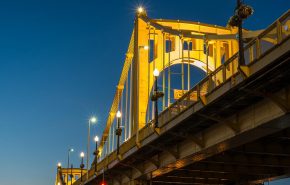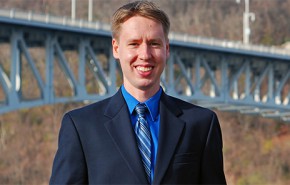Todd Wilson, PE, MBA is one of hundreds of skilled GAI professionals who help clients create better communities, transportation infrastructure, energy generation and delivery, and more from our office locations throughout the United States. Today we’ll find out a little about what makes Todd tick—the background, motivation, and methods that he brings to the table every day for GAI and GAI’s clients.
Q: Please tell us a little about how you arrived at your area of specialization.
Todd Wilson: I’ve specialized in traffic engineering for 15 years. Growing up in Pittsburgh, I was fascinated by how the city’s roads, bridges, and tunnels were designed to overcome topographical challenges. My father was a photographer and my mother an art teacher, and early on they encouraged me to photograph and draw the city’s bridges. I started planning far-ranging family road trips, which led to a broader interest in how roads and highways fit together as a system. The fascination that began in childhood led me to pursue civil engineering in college, and after taking a transportation engineering class, I realized traffic engineering would allow me to be involved with the greatest variety of projects ranging from planning to analysis to design.
As a side note—the interest encouraged by my parents has stayed with me, and today I have photographed bridges in all 50 U.S. states and 25 countries.
Q: What role do you play at GAI, and what sorts of projects do you typically contribute to?
Todd: I contribute to traffic engineering tasks for a wide variety of projects across disciplines for various public and private clients, serving in engineering and task manager roles. Many of GAI’s transportation infrastructure projects have a traffic or mobility component. For example, roadway and bridge projects require maintenance and protection of traffic plans during construction and signing, pavement marking, and traffic signal plans for completion. They also require other engineering tasks such as safety studies and capacity analyses. Energy projects may require traffic studies, traffic plans, or permitting when roadways are impacted by construction. Development projects require studies to assess their traffic impact, often involving traffic modeling. Traffic planning projects look at pedestrian, bicycle, and transit circulation and access. In a typical day I may work on several projects at once, often for different GAI office locations.
“Engineering is a team effort. True success is when team members support each other and put out a quality project that is on time, on budget, and well received by our client.”
Q: What do you like most about your job, and why do you feel GAI is a good place to put your skills to work?
Todd: GAI has a great team of well-qualified engineers, planners, landscape architects, and economists, and I appreciate working with and learning from my coworkers and managers. From a project perspective, I really appreciate the ability to make positive change, especially when given the opportunity to make a road or intersection safer or operate more efficiently.
In one GAI project, I had the opportunity to perform the official traffic study to determine the types of improvements needed to reconfigure a busy multi-lane road into a complete street that better serves all users—drivers, cyclists, transit riders, and pedestrians. Construction was completed in 2019. Driving through the project area a few weeks ago, I remarked at how I was able to progress at a slow pace while getting every light green alongside pedestrians who were better buffered from traffic and cyclists who were able to travel free from vehicular conflict. Being able to personally experience the design improvements that I had a hand in creating is one of the things I like most about my job.
GAI is large enough to have excellent staff who can tackle complex problems, yet small enough to offer employees creativity in solving client and business needs. I am fortunate to work with so many talented staff members, personnel managers, and project managers across several offices, and the people at GAI make it an excellent place to work. To solve a client need, I can confidently reach out to and work with excellent engineers, economists, and landscape architects located in any of GAI’s offices around the country. Being able to combine such a large and diverse talent pool provides great value to our clients.
Q: How do you measure your success?
Engineering is a team effort. True success is when team members support each other and put out a quality project that is on time, on budget, and well received by our client. Success is being told by a client that we are being hired for future work because of excellent past performance or when a client becomes excited when we propose a plan to solve their needs in a way they did not think of before. A personal highlight was when a client told me and the project manager that we were selected for their project because of their confidence we would be able to solve their needs creatively and innovatively throughout the project process.
I believe a major measurement of success is earning the opportunity to give back and to help inspire others, such as being asked to join the volunteer committees and nonprofit boards that I’m currently involved with. Perhaps the best part for me has been serving on scholarship committees, recognizing the next group of talented students, and helping them to succeed.
Q: How do you feel that the job you do at GAI benefits the community and the world?
Traffic engineering aims to solve the problem of how to best keep everyone moving as safely and efficiently as possible to benefit all users. Through safety studies, we work to reduce the frequency and severity of crashes. For transit planning projects, we help make transit use easier and resolve access concerns, especially for those who may have mobility challenges. For capacity improvement projects, we help reduce travel times for the traveling public. For bridge projects, we help to keep traffic moving so bridges can be built, replaced, or undergo needed repairs. Needless to say, civil engineering in general is a profession that has wide impact on many facets of peoples’ daily lives and works to offer many real benefits for the communities we serve.
More insights into Todd Wilson and GAI’s Traffic Engineering practice:
- Pittsburgh Civil Engineering: An Enthusiast’s Inspirations
- Traffic Engineering Transforms Busy Intersection
- Peanut Roundabout Cracks Traffic Safety Challenge
- Remembering Fred Graham, PE, Standout Pittsburgh Civil Engineer
- New Roundabout a Point of Pride for Indiana’s City of Beech Grove
- 5 Traffic Engineering Strategies for Safer Urban Intersections
- GAI Engineer Authors Book, Tells Visual Story of “City of Bridges”
Contact Todd at 412.399.5299 and find out more about GAI’s traffic engineering as well as other transportation and civil engineering services—message GAI online and start the conversation about how our multidiscipline professionals can meet your unique project needs.
![]() Todd Wilson, PE, MBA specializes in traffic-related civil engineering for transportation projects and conducts various types of traffic studies and design plan, including traffic impact studies, safety audits, transit-oriented development projects, and parking studies. He performs traffic design and plan preparation for traffic control, signalization, signing, and pavement marking projects. Todd is an active member of numerous professional societies, including the Carnegie Mellon University Department of Civil and Environmental Engineering’s Alumni Advisory Council.
Todd Wilson, PE, MBA specializes in traffic-related civil engineering for transportation projects and conducts various types of traffic studies and design plan, including traffic impact studies, safety audits, transit-oriented development projects, and parking studies. He performs traffic design and plan preparation for traffic control, signalization, signing, and pavement marking projects. Todd is an active member of numerous professional societies, including the Carnegie Mellon University Department of Civil and Environmental Engineering’s Alumni Advisory Council.
Todd Wilson is the co-author of book Images of America: Pittsburgh’s Bridges, a contributor to the American Society of Civil Engineers’ Engineering Pittsburgh: A History of Roads, Rails, Canals Bridges & More, and the author of several published articles.


